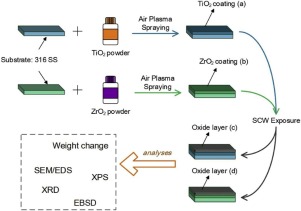The Journal of Supercritical Fluids ( IF 3.4 ) Pub Date : 2019-12-09 , DOI: 10.1016/j.supflu.2019.104716 Shuwei Guo , Donghai Xu , Yu Liang , Yanmeng Gong , Yanhui Li , Jianqiao Yang

|
Alloy 316 stainless steel (SS) is an important candidate material for supercritical water oxidation facilities, but severe corrosion negatively affects its life-span and potential application. In this work, ZrO2 and TiO2 were coated on the 316 SS substrate by air plasma spraying and then exposed in oxygenated sub- and supercritical water. The results show that the coatings could greatly improve the corrosion resistance of 316 SS in oxygenated sub- and supercritical water in the range from 300 °C to 480 °C at 24 MPa with 3 wt% of oxygen content for 100 h. Increasing temperature accelerated the corrosion of tested TiO2- and ZrO2-coated samples. ZrO2 and TiO2 coatings could inhibit the outward diffusion of metal elements in the 316 SS substrate and the inward diffusion of oxygen. The oxide film of the ZrO2-coated sample was composed of Cr2O3, Fe3O4, Fe2O3, NiFe2O4 and NiCr2O4, while that of the TiO2-coated sample consisted of Cr2O3, Fe3O4 and Cr2MoO6 at 480 °C. Compared with the ZrO2 coating, the TiO2 coating exhibited better protective effects on reducing 316 SS corrosion in oxygenated supercritical water. The TiO2- coated sample led to lower absolute values of weight changes, more uniform and denser corrosion surface, and better inhibition on the outward diffusion of metal elements (especially Ni) and on the inward diffusion of O. This suggests that the TiO2 coating on the 316 SS substrate via air plasma spraying is an effective approach to improve 316 SS corrosion resistance in tested oxygenated supercritical water.
中文翻译:

空气等离子喷涂316不锈钢在氧化的亚临界和超临界水中对ZrO 2和TiO 2陶瓷涂层的腐蚀特性
316不锈钢(SS)合金是超临界水氧化设施的重要候选材料,但严重腐蚀会对它的寿命和潜在应用产生负面影响。在这项工作中,通过空气等离子喷涂将ZrO 2和TiO 2涂覆在316 SS基板上,然后将其暴露在含氧的亚临界和超临界水中。结果表明,该涂层可以在300℃至480℃,24 MPa,含氧量3 wt%的条件下持续100 h改善含氧亚临界和超临界水中316 SS的耐腐蚀性。温度升高加速了测试的TiO 2和ZrO 2涂层样品的腐蚀。ZrO 2和TiO 2涂层可以抑制316 SS基材中金属元素的向外扩散和氧气的向内扩散。ZrO 2涂层样品的氧化膜由Cr 2 O 3,Fe 3 O 4,Fe 2 O 3,NiFe 2 O 4和NiCr 2 O 4组成,而TiO 2涂层样品的氧化膜由Cr组成。480°C下的2 O 3,Fe 3 O 4和Cr 2 MoO 6。与ZrO 2涂层相比,TiO2涂层在减少含氧超临界水中的316 SS腐蚀方面表现出更好的保护作用。涂覆TiO 2的样品导致重量变化的绝对值降低,腐蚀表面更均匀且致密,并且对金属元素(尤其是Ni)的向外扩散和O的向内扩散的抑制作用更好。这表明TiO 2通过空气等离子喷涂在316 SS基材上进行涂层是一种有效的方法,可以提高测试过的含氧超临界水中的316 SS耐腐蚀性。











































 京公网安备 11010802027423号
京公网安备 11010802027423号